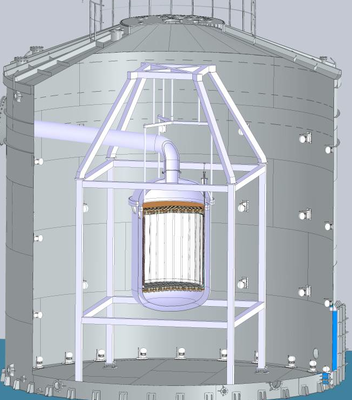DARWIN/XLZD

Dark matter experiments with target masses beyond the ton scale are alreday reality. Our group participates in XENON which currently operates a detector filled with more than 8 tons of liquid xenon, of which 5.9 tons act as dark matter target.
In case of a positive dark matter detection in this detector a larger instrument will be required in order to study the properties of the dark matter particle. If nothing is found, these larger detectors will be needed as well in order to fully explore the predicted parameter space for WIMP dark matter in order to either detect it at even lower cross sections or to constrain it even further. The ultimate threshold for WIMP searches is at spin-independent WIMP-nucleon scattering cross sections of a few 10-49 cm2, where coherent neutrino interactions with atomic nuclei become the dominating background and which cannot be shielded.

Fig: An artist's impression of the DARWIN detector inside its Cerenkov shield.
In order to have the technology ready when it becomes necessary to build these detectors, the DARWIN project was initiated. The project combines the expertise of many experimental physicists working with liquid xenon to detect dark matter. The DARWIN goal is to eventually build the ultimate WIMP detector with a target mass of at least ~40 tons of liquid xenon. This detector might be realized within the XLZD consortium, uniting the XENON, DARWIN and LUX-ZEPLIN collaborations.
A detector of this size will be limited by background from neutrinos which, however, are also an interesting physics case itself. Typical neutrino experiment has much higher thresholds but DARWIN/XLZD could directly measure low energetic solar neutrinos (pp, 7Be). Thanks to its extremely low background as well as low threshold, many other science channels will be accessible in DARWIN/XLZD, including supernova neutrinos, axions/axion-like particles as well as rare decays of 136Xe and 124Xe.
The Freiburg group currently concentrates on the following topics:
- We study possibilities to build such large detectors/time projection chambers and pursue dedicated experiments to study alternative or improved detector concepts.
This work was also supported by the ERC-funded ULTIMATE project. - We are operating the world's largest LXe detector test platform PANCAKE, which allows studying and developing of TPC components with a diameter of more than 2.6m (but of limited height).
- We participate in studies on the physics reach of such a large detector with its extraordinary low radioactive background.
- We operate and develop instruments to identify low-background materials and components.
DARWIN/XLZD is an international consortium of more than 400 people. It combines ample expertise on dark matter search with liquid xenon, from neutrino and high energy physics, and with backgrounds from extremely low backgrounds to particle physics theory.
Marc Schumann serves as deputy spokesperson of the DARWIN collaboration and is a member of the XLZD Steering Committee..
Further Information
- Official DARWIN website
- Official XLZD website
- ULTIMATE website
- M. Schumann (DARWIN), arXiv:1111.6251.
- J. Aalbers et al. (DARWIN), DARWIN: towards the ultimate dark matter detector [JCAP 11, 017 (2016)].





